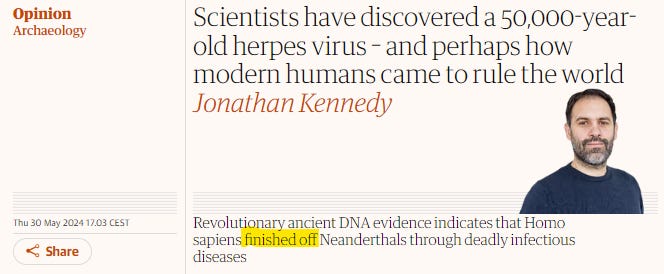The Trouble with Classifying Nature
Part 2: The story of our "species" and how we craft the value of being human

For Rewind Wednesday, I reflected on our ancient history of venereal disease, in what I thought might serve as a cute anecdote and reprieve from the heaviness and density of related topics this week. But a follow-up article published by The Guardian yesterday went ahead and illustrated precisely why the core message of this two-parter is so important. As The Guardian’s headline writer described the op-ed piece:
Scientists have discovered a 50,000-year-old herpes virus—and perhaps how modern humans came to rule the world. Revolutionary ancient DNA evidence indicates that Homo sapiens finished off Neanderthals through deadly infectious diseases.
No.
Bad headline writer. Very bad.
And quite honestly, the op-ed writer’s concluding remarks are also an issue. Without noting that the study in question was a preprint, awaiting full peer review, he wrote:
The reason that Homo sapiens survived while Neanderthals disappeared is simple. Our ancestors lived closer to the equator. As more of the sun’s energy reaches the Earth, plant life is more abundant there. This provides a habitat for more dense and varied animal life, which in turn supports more microbes that are capable of jumping the species barrier and infecting humans. Consequently, Palaeolithic Homo sapiens would have carried more deadly pathogens than Neanderthals.
The ancient DNA revolution is not only transforming our understanding of prehistory – it also has important implications for the present. If infectious diseases played such a critical role in Neanderthals’ disappearance and Homo sapiens’ rise to world domination, then pathogens are far more powerful than we ever realised. Our ancestors 50,000 years ago had germs on their side, but we might not be so lucky in the future.
Reader, I trust you know to suspect any claim that the answer to an ancient biological question is “simple”. But this whole narrative structure, from the headline and deck through to the closing paragraphs, relies on a notion of direct competition that takes a lot for granted about the nature and knowledge of early humanity—and that’s precisely what I wanted to discuss when I first bit off more than I could chew, and tried to write about our weird formal relationship to the natural world.
In Part 1 of this reflection, we looked at the strange, shifting priorities that mark humanity’s struggle to classify animals and other living materials. We looked at how fluid the notion of a “species” is, why it took so long to create the organizational systems we have today, how recent those systems are, and how they can distract us from the most critical information we need to understand our eco-crisis.
For paid subscribers, I closed on the following note:
Do the names of things we use to talk about the world accurately describe the world? Wrong question. But do we know what the right one is?
And below the paywall, we’re going to continue that chat around one species in particular: our own. More to the point, we’re going to look at different ways we’ve presented ourselves in relation to other early primate species, and what the struggle to distinguish ourselves from other critters reveals about our sense of self.
We’re also going to look at how those priorities did and did not shift, once genetic information became more readily available. What we’re not going to talk about—at least, not nearly as much—is all the technical nuance surrounding that more recent information. In part this is because, not long after I posted Part 1, a most excellent Substack here,
by Stetson, published a lovely summary of the findings of genetic analysis recorded in A Short History of Humanity: A New History of Old Europe by Johannes Krause and Thomas Trappe.Why try to replicate already excellent work?
For those who won’t be joining us below the fold, then, I heartily recommend sitting with “A Brief Genetic History of Europe”, then doubling back to a 2021 post from another excellent Substack here,
’s Unsupervised Learning. These two scientists (molecular medicine, neuroscience, and genetics research between them) have told the story on the technical side far better than I could, and Khan also goes into some beautiful historical analysis, which I’ll lean on briefly below.My interest is more in how we tell stories about ourselves, and how those stories shape our media literacy, scientific literacy, and capacity to adapt to new information. As much as we might like to think of ourselves as pretty good assessors of new information on its own merits, we cannot help but analyze new data in light of past exposures. We undergo “calcification”, leaning on the paradigms and figurative language of our upbringing like broken records—but then, why wouldn’t we?
When before, in the deep time of our species, has so much new information become available to us in so short a time frame?
Genetics research started to inform paleo-anthropology in the last forty years: a mere blip in cosmic time, and long enough for many people’s primary school educations to be undone by new advances. In these last few decades, we’ve raced ahead in terms of raw data about our natural world—but has enough time passed for us to be able to adjust our figurative vocabulary to match all these technical corrections?
What are the stories we’ve been telling ourselves about ourselves—and how do these persistent, ancient ways of classifying our place in nature continue to shape our world?
Keep reading with a 7-day free trial
Subscribe to Better Worlds Theory to keep reading this post and get 7 days of free access to the full post archives.



